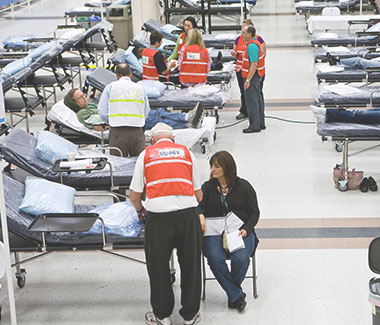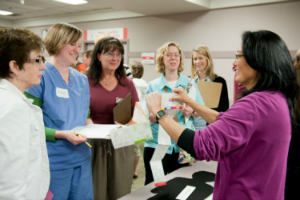

Preparing for a surge in hospital patients
In late December 2016, Pierce County’s two largest hospitals were operating at maximum capacity. Emergency medical service providers were struggling to find emergency departments with available bed space, often forcing ambulances to drive long distances to deliver patients to care.
Hospitals nearly always see an increase in patients during winter flu season, but seldom to this degree. In the third week of December within CHI Franciscan Health, which operates nine hospitals in Western Washington, between 65 and 100 percent of emergency room beds were occupied by patients who were waiting to be admitted to the hospital.
“We quickly realized that this was not just an emergency department problem,” says Cindy Miron, Program Manager of Emergency Preparedness at the Tacoma-Pierce County Health Department (TPCHD). Inpatient beds were full. Outpatient clinics were seeing higher than normal capacity. Long-term care facilities were reluctant to accept patients ready for discharge out of concern for potential outbreaks among their vulnerable residents.
Response Activation
Similar reports from King and Snohomish counties led the Washington State Department of Health (DOH) to convene a call with local health officials in early January. Four days later, the Northwest Healthcare Response Network (the Network), the healthcare coalition serving King and Pierce counties, activated its Healthcare Emergency Coordination Center (HECC) to gather information that would help regional and state authorities decide how to address the problem.
“One of the challenges was figuring out what was causing this and what, therefore, was the solution,” says Nigel Turner, Director of Communicable Disease Control at TPCHD. “What the Network brought to this was a structure that could allow that type of analysis to happen.”
Over the next six weeks, the Network polled healthcare organizations weekly regarding trends in flu cases, bed capacity, staffing shortages and strategies for addressing them. Results were compiled in Healthcare Impact Reports that were shared with local and state public health leadership and healthcare stakeholders. Hospitals all along the Interstate 5 corridor had been struggling with a rising daily census for more than two years. Since the reports indicated this was not a particularly severe flu season, it was determined that the ongoing capacity issues had become so severe that some facilities now lacked the space and resources to handle even minor surges in patients without activating their disaster plans.
Situational Awareness
The Network’s reports assured providers that their challenges were part of a larger problem that had the attention of the state’s highest authorities. “These communications were really helpful for me as a leader,” says Margo Bykonen, Chief Nursing Officer for Swedish Health Services. “It’s really hard for staff trying to place all these patients and not having any bit of a break. So to be able to see that we were not alone in this, that this was a community-wide struggle, not just within the Swedish system, was a big deal.”
The reports inspired some non-hospital facilities to take measures to lighten the burden on emergency departments. The Polyclinic, which includes nearly a dozen outpatient centers in King County, stepped up its standard flu season employee vaccination and education campaigns, and encouraged providers to minimize referrals to hospitals whenever safely possible.
“Knowing what was happening in the hospital sector gave me the information I needed to make sure we were ready if this became a bigger issue,” says Judy Mitacek, formerly the Polyclinic’s Business Continuity and Compliance Coordinator for Disaster Preparedness. “In an emergency, not everything can happen in the hospital setting. Outpatient settings have to share part of the burden of taking care of all of our patients in King County.”
Planning Pays Off
In addition to situational awareness from the Healthcare Impact Reports, healthcare organizations benefited from previous efforts to plan for surge situations. In recent years, the Network had hired consultants to assist regional hospitals in identifying ways to accommodate extra patients in the event of a crisis. St. Joseph Medical Center, a CHI Franciscan hospital in Tacoma, used that planning at the height of this winter’s capacity challenges to add 20 temporary beds by converting single rooms in its orthopedic wing to double occupancy and implementing contingent staffing plans.
Facilities across the region exercised relationships they’d built through the Network to share best practices for meeting the community’s healthcare needs. Several important conversations revolved around the work of the Network’s Disaster Clinical Advisory Committee, funded almost entirely through the HPP. This group of providers and health department representatives meets quarterly to develop regional strategies for clinically responsible decision-making in times of crisis when the community might face a shortage of important resources ranging from staff to medicines. “Having those ethically challenging conversations up front about how we provide care when there are limited clinical resources is so valuable,” says Bykonen, who has served on the committee since 2012.
As the flu season waned in late February, hospital censuses returned to their previous numbers, still much higher than ideal. Armed with the knowledge that daily capacity problems mean that a disaster could overwhelm the healthcare system, state and local health authorities, supported by the Network and regional healthcare leaders, are convening a task force to root out causes and seek long-term remedies. Programs funded by the U.S. Office of the Assistant Secretary for Preparedness and Response and Network members are critical to that effort. “Without them, you wouldn’t have the tools to support healthcare in making tough decisions about resource allocation or space allocation,” says Michael Loehr, Chief of the Washington State Department of Health Office of Emergency Preparedness and Response. “That would have to be made up on the fly, and that’s not a good place to be in a disaster.”
In A Disaster
The work of the coalition allows our community to:
- Share information that supports crisis decision-making
- Analyze and report trends affecting healthcare delivery
- Create additional healthcare capacity when needed
- Work collectively to solve common problems
Other Impact Stories


Impact Focus:
Multi-Agency Coordination
Ensuring Capacity...
The Challenge At least 25% of the population of the state of Washington is a pediatric patient, specifically under the… Read more »



Impact Focus:
Evacuation
Partnerships and...
Challenge: Relocating 77 vulnerable residents from a skilled nursing facility in rural Washington during a fire evacuation emergency. Montesano, Washington… Read more »


Impact Focus:
Situational Awareness
Extreme Heat...
The Network spearheads coordination and collaboration to save lives during an extreme heat response. In late June 2021, amidst a… Read more »

